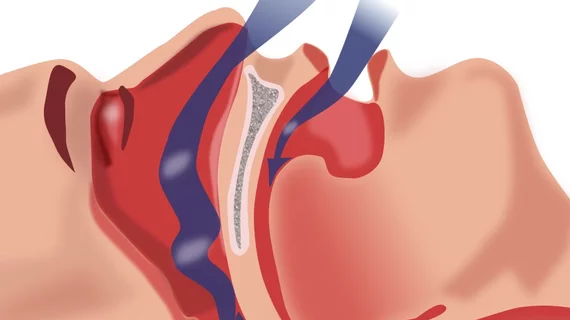Patients with resistant hypertension and obstructive sleep apnea (OSA) experienced significant drops in blood pressure and improvements in OSA severity following renal denervation (RDN), according to a small randomized trial published June 25 in Hypertension.
Previous trials have been inconclusive regarding RDN's potential to lower blood pressure, but the authors believe patients with sleep apnea could particularly benefit from the procedure.
“Increased sympathetic activity, consistently evident in patients with OSA, likely plays a key role in the development of resistant hypertension,” wrote lead author Ewa Warchol-Celinska, MD, PhD, with the Institute of Cardiology in Warsaw, Poland, and colleagues. “It has been suggested that renal sympathetic nerves modulate sodium homeostasis, with renal nerve activation enhancing sodium retention. Suppressing effects of sympathetic activation by RDN may blunt or reverse this response.”
The researchers randomized 60 patients with resistant hypertension and moderate to severe OSA to either RDN or no intervention. All patients had an office systolic blood pressure above 140 mm Hg, ambulatory blood pressure above 135 mm Hg on average and were taking three or more antihypertensive drugs for at least four weeks before screening. There were no significant differences in clinical characteristics and the same number of men and women in each group.
Warchol-Celinska et al. found:
- At three months, systolic office BP levels dropped an average of 22 mm Hg in the treatment group and 5 mm Hg in the control group. Diastolic office BP levels dropped an average of 9 and 3 mm Hg, respectively.
- The BP drop was statistically significant for the systolic readings but not the diastolic readings.
- Apnea/hypopnea index (AHI) at three months dropped from 39.4 to 31.2 events per hour for patients who received renal denervation, while there were no significant differences detected in the control group. Patients with severe OSA at baseline and patients who weren’t on continuous positive airway pressure treatment had the largest decreases in AHI.
- Lower BP levels persisted to six months of follow-up for those who received renal denervation. These patients also showed significant improvements in global longitudinal strain—a measure of left ventricular function.
“The effect of catheter-based therapy on BP in patients with resistant hypertension and polysomnographically proven coexisting OSA has not previously been evaluated in a prospective randomized trial,” the researchers wrote. “In our study, we show for the first time, pronounced BP-lowering effects of RDN in patients with OSA compared with randomized controls both on office and ambulatory BP measurements.”
However, given the small sample size of the study, the authors said their results should be considered “proof-of-concept,” with larger trials necessary to confirm the benefits of RDN for this patient population. And despite the positive effects on BP and OSA, RDN wasn’t associated with significant changes in glucose metabolism, Warchol-Celinska and coauthors noted.
The ablations in this study were only applied in the main renal artery, while recent research has shown RDN may be more efficient when also applied in the renal artery branches or distal segments of the main renal artery. In addition, newer catheters have become available since the trial began, which may further improve outcomes.

